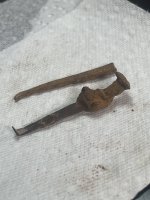IronAudio
Newbie
- Oct 5, 2013
- 3
- 2
- Detector(s) used
- Garrett AT Pro
- Primary Interest:
- All Treasure Hunting
I hope this is the most appropriate forum... sorry if not.
I need help understanding the below (directions from early 1800's):
Start near the oak and maple on the north east branch of the *** Fork of the *** River, running thence due north (number) poles to an elm and mulberry... then east (number) poles to an ash and black oak... passing through a small lake in (number) rising hill in (number)... thence south (number) poles to a chinkapin oak and cedar on crossing a small branch in (number)
There are a couple parts that are not clear to me. Noted in RED
I assume the reference to poles are fence posts? What was the nominal distance back then? Because I know they are for sure gone!
Are the other numbers not referring to posts steps or something? Maybe a parcel number? I cant find a map on this area from then... were decendants of the first settlers from the area. SW of St. Louis MO
Any advice?
Think those trees are still there? NOT
I need help understanding the below (directions from early 1800's):
Start near the oak and maple on the north east branch of the *** Fork of the *** River, running thence due north (number) poles to an elm and mulberry... then east (number) poles to an ash and black oak... passing through a small lake in (number) rising hill in (number)... thence south (number) poles to a chinkapin oak and cedar on crossing a small branch in (number)
There are a couple parts that are not clear to me. Noted in RED
I assume the reference to poles are fence posts? What was the nominal distance back then? Because I know they are for sure gone!
Are the other numbers not referring to posts steps or something? Maybe a parcel number? I cant find a map on this area from then... were decendants of the first settlers from the area. SW of St. Louis MO
Any advice?
Think those trees are still there? NOT
Last edited:




